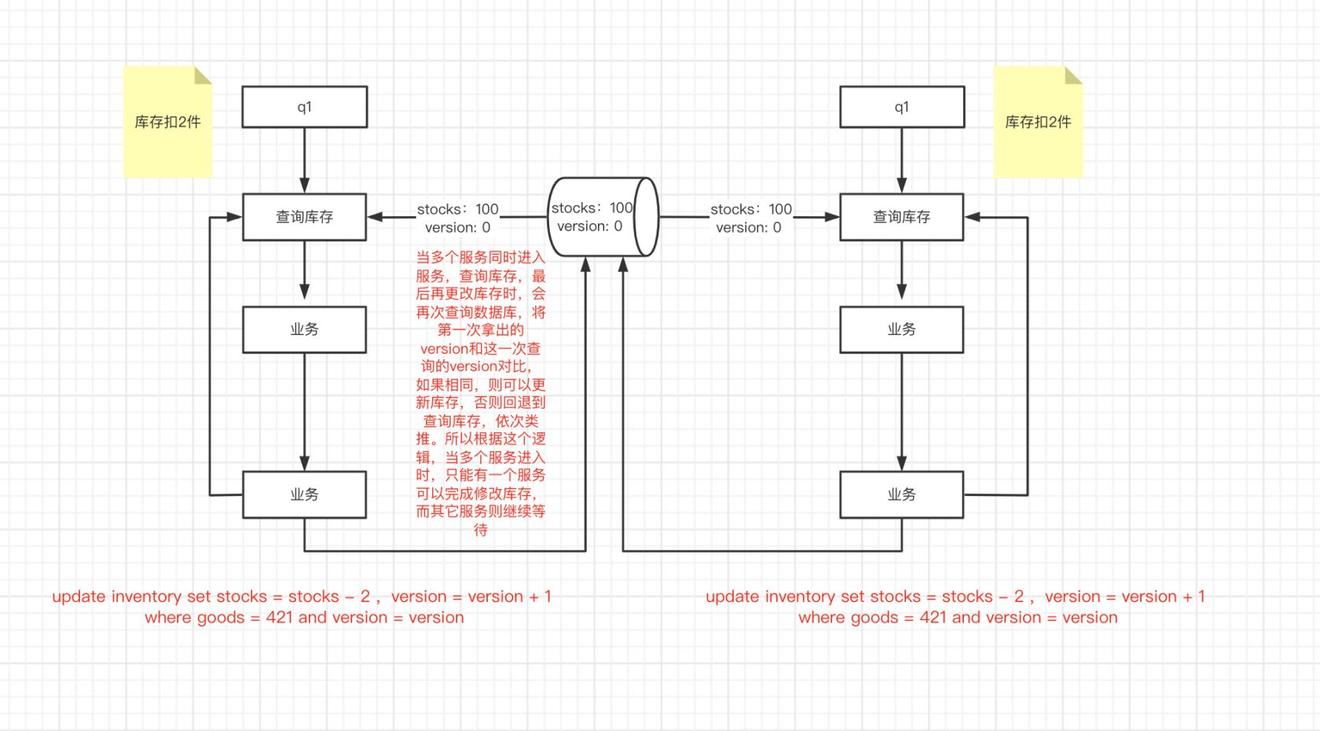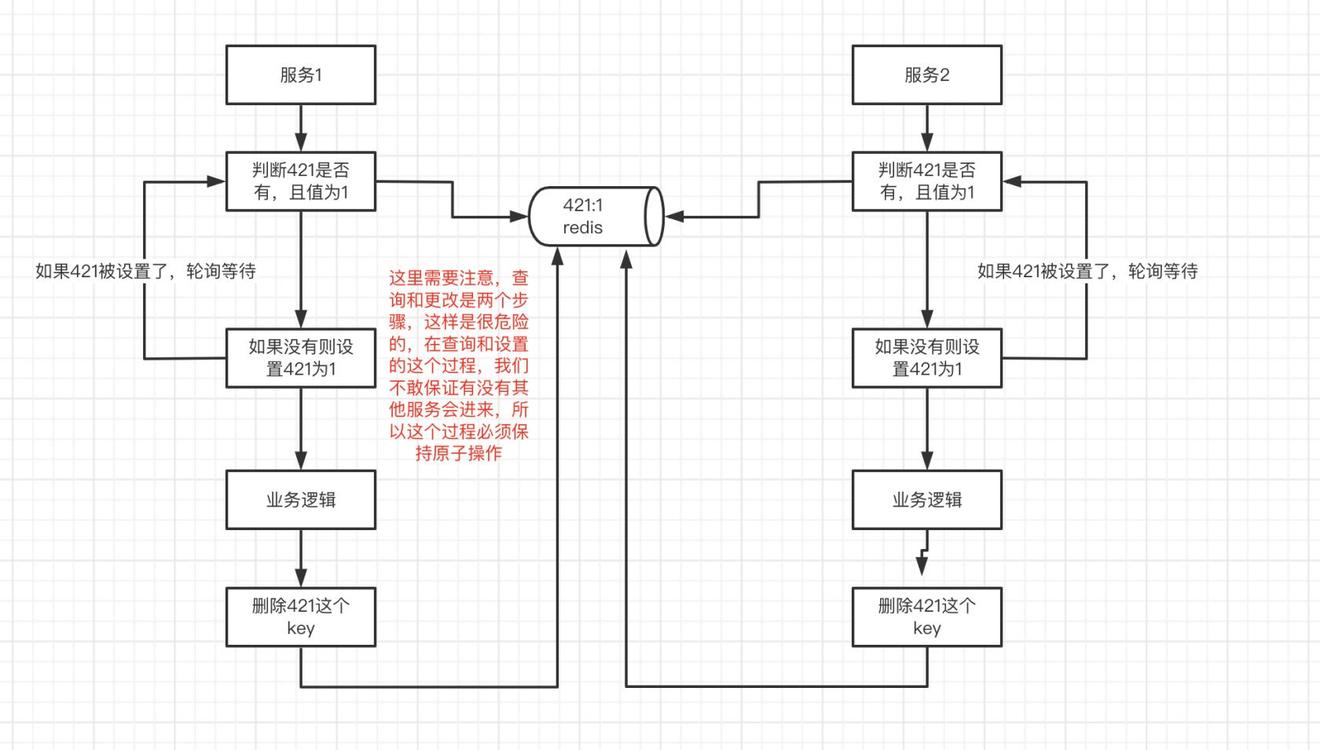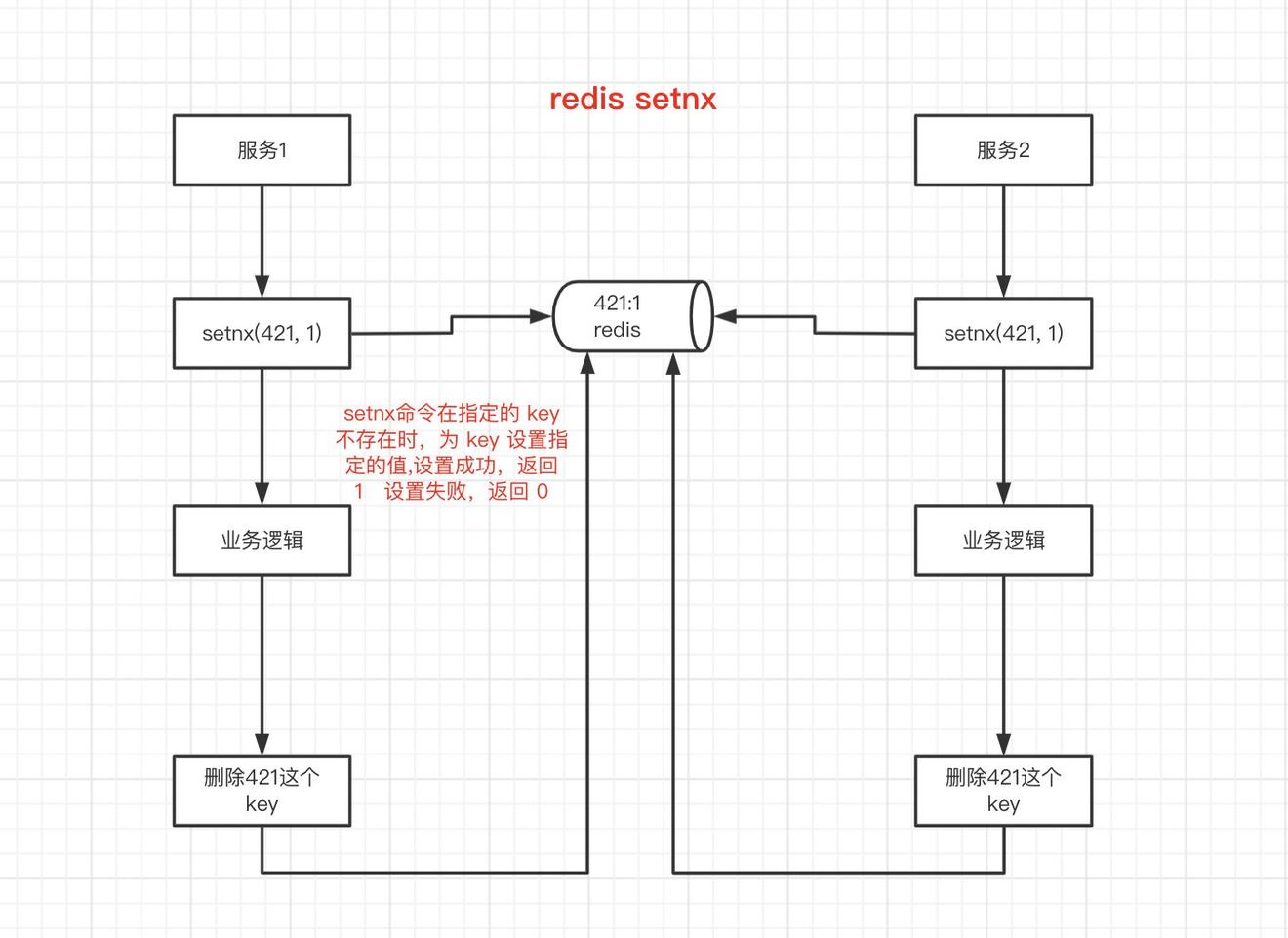基于mysql分布式悲观锁原理
悲观锁在库存服务中的应用:
在这个过程中我们是使用gorm来完成mysql的分布式悲观锁的
核心的代码在这里,该方法就能完成悲观锁了
DB.Clauses(clause.Locking{Strength: "UPDATE"})
完整代码:
| //Sell 扣减库存,涉及事务逻辑,执行的逻辑必须全部成功或者全部失败并且失败后数据可恢复,不能中途失败 | |
| func (i *InventoryServer) Sell(ctx context.Context, req *proto.SellInfo) (*empty.Empty, error) { | |
| //并发情况下可能会出现超买,需要使用锁来将并发串行化 | |
| //事务开始 | |
| tx := global.DB.Begin() | |
| //悲观锁 对数据库进行上锁,会降低一定性能 | |
| var inventory model.Inventory | |
| if result := tx.Clauses(clause.Locking{Strength: "UPDATE"}).Where(&model.Inventory{Goods: goodsInfo.GoodsId}).First(&inventory); result.RowsAffected == 0 { | |
| //失败进行事务回滚 | |
| tx.Rollback() | |
| return nil, status.Errorf(codes.InvalidArgument, "库存信息不存在") | |
| } | |
| if inventory.Stocks < goodsInfo.Num { | |
| //失败进行事务回滚 | |
| tx.Rollback() | |
| return nil, status.Errorf(codes.ResourceExhausted, "库存不足") | |
| } | |
| inventory.Stocks -= goodsInfo.Num | |
| tx.Save(&inventory) | |
| //提交事务 | |
| tx.Commit() | |
| return &empty.Empty{}, nil | |
| } |
2. 分布式乐观锁:
原理:
如图:

乐观锁的应用
| func (i *InventoryServer) Sell(ctx context.Context, req *proto.SellInfo) (*empty.Empty, error) { | |
| //并发情况下可能会出现超买,需要使用锁来将并发串行化 | |
| //事务开始 | |
| tx := global.DB.Begin() | |
| for _, goodsInfo := range req.GoodsInfo { | |
| //分布式乐观锁 | |
| var inventory model.Inventory | |
| for { | |
| if result := global.DB.Where(&model.Inventory{Goods: goodsInfo.GoodsId}).First(&inventory); result.RowsAffected == 0 { | |
| //失败进行事务回滚 | |
| tx.Rollback() | |
| return nil, status.Errorf(codes.InvalidArgument, "库存信息不存在") | |
| } | |
| if inventory.Stocks < goodsInfo.Num { | |
| //失败进行事务回滚 | |
| tx.Rollback() | |
| return nil, status.Errorf(codes.ResourceExhausted, "库存不足") | |
| } | |
| inventory.Stocks -= goodsInfo.Num | |
| //注意这里gorm在处理零值时,他会自动忽略零值的更新,这里需要使用select强制更新某些字段 | |
| if result := tx.Model(&model.Inventory{}).Select("Stocks", "Version").Where("goods = ? and version = ?", | |
| goodsInfo.GoodsId, inventory.Version).Updates(model.Inventory{Stocks: inventory.Stocks, Version: inventory.Version + 1}); result.RowsAffected == 0 { | |
| zap.S().Info("库存扣减失败") | |
| } else { | |
| break | |
| } | |
| } | |
| } | |
| tx.Commit() | |
| return &empty.Empty{}, nil | |
| } |
基于redis的分布式锁
原理:

setnx命令
Redis Setnx(SET if Not eXists) 命令在指定的 key 不存在时,为 key 设置指定的值。
语法
redis Setnx 命令基本语法如下:
redis 127.0.0.1:6379> SETNX KEY_NAME VALUE
返回值
设置成功,返回 1 。 设置失败,返回 0 。

- setnx的作用
- 将获取和设置值变成原子性的操作
- 如果我的服务挂掉了- 死锁
- 设置过期时间
- 如果你设置了过期时间,那么如果过期时间到了我的业务逻辑没有执行完怎么办?
- 在过期之前刷新一下
- 需要自己去启动协程完成延时的工作
- 延时的接口可能会带来负面影响 - 如果其中某一个服务hung住了, 2s就能执行完,但是你hung住那么你就会一直去申请延长锁,导致别人永远获取不到锁,这个很要命
- 分布锁需要解决的问题 - lua脚本去做
- 互斥性 - setnx
- 死锁
- 安全性
- 锁只能被持有该锁的用户删除,不能被其他用户删除
- 当时设置的value值是多少只有当时的g才能知道
- 在删除的时取出redis中的值和当前自己保存下来的值对比一下
这样我们使用setnx就可以完成原子操作了
下面来看看如何使用redisync
redisync
| package main | |
| import ( | |
| "fmt" | |
| "sync" | |
| "time" | |
| goredislib "github.com/go-redis/redis/v8" | |
| "github.com/go-redsync/redsync/v4" | |
| "github.com/go-redsync/redsync/v4/redis/goredis/v8" | |
| ) | |
| func main() { | |
| // Create a pool with go-redis (or redigo) which is the pool redisync will | |
| // use while communicating with Redis. This can also be any pool that | |
| // implements the `redis.Pool` interface. | |
| client := goredislib.NewClient(&goredislib.Options{ | |
| Addr: "localhost:6379", | |
| }) | |
| pool := goredis.NewPool(client) // or, pool := redigo.NewPool(...) | |
| // Create an instance of redisync to be used to obtain a mutual exclusion | |
| // lock. | |
| rs := redsync.New(pool) | |
| var wg sync.WaitGroup | |
| wg.Add(3) | |
| for i := 0; i < 3; i++ { | |
| go func() { | |
| defer wg.Done() | |
| mutexname := fmt.Sprintf("mytest_%s", i) | |
| mutex := rs.NewMutex(mutexname) | |
| if err := mutex.Lock(); err != nil { | |
| panic(err) | |
| } | |
| fmt.Printf("获取锁成功\n") | |
| time.Sleep(time.Second * 1) | |
| fmt.Printf("执行结束\n") | |
| if ok, err := mutex.Unlock(); !ok || err != nil { | |
| panic("unlock failed") | |
| } | |
| fmt.Printf("释放锁成功\n") | |
| }() | |
| } | |
| wg.Wait() | |
| } |
在库存服务中的应用:
| //Sell 扣减库存,涉及事务逻辑,执行的逻辑必须全部成功或者全部失败并且失败后数据可恢复,不能中途失败 | |
| func (i *InventoryServer) Sell(ctx context.Context, req *proto.SellInfo) (*empty.Empty, error) { | |
| //并发情况下可能会出现超买,需要使用锁来将并发串行化 | |
| //将数据库作为事务性 | |
| tx := global.DB.Begin() | |
| var mutexs []*redsync.Mutex | |
| for _, goodsInfo := range req.GoodsInfo { | |
| var inventory model.Inventory | |
| mutex := global.Rs.NewMutex(fmt.Sprintf("goods_%d", goodsInfo.GoodsId)) | |
| if err := mutex.Lock(); err != nil { | |
| return nil, status.Errorf(codes.Internal, "获取redis分布式锁异常") | |
| } | |
| if result := global.DB.Where(&model.Inventory{Goods: goodsInfo.GoodsId}).First(&inventory); result.RowsAffected == 0 { | |
| //失败进行事务回滚 | |
| tx.Rollback() | |
| return nil, status.Errorf(codes.InvalidArgument, "库存信息不存在") | |
| } | |
| if inventory.Stocks < goodsInfo.Num { | |
| //失败进行事务回滚 | |
| tx.Rollback() | |
| return nil, status.Errorf(codes.ResourceExhausted, "库存不足") | |
| } | |
| inventory.Stocks -= goodsInfo.Num | |
| tx.Save(&inventory) | |
| mutexs = append(mutexs, mutex) | |
| //if ok, err := mutex.Unlock(); !ok || err != nil { | |
| // return nil, status.Errorf(codes.Internal, "释放redis分布式锁异常") | |
| //} | |
| } | |
| tx.Commit() | |
| for _, mutex := range mutexs { | |
| if ok, err := mutex.Unlock(); !ok || err != nil { | |
| return nil, status.Errorf(codes.Internal, "释放redis分布式锁异常") | |
| } | |
| } | |
| return &empty.Empty{}, nil | |
| } |